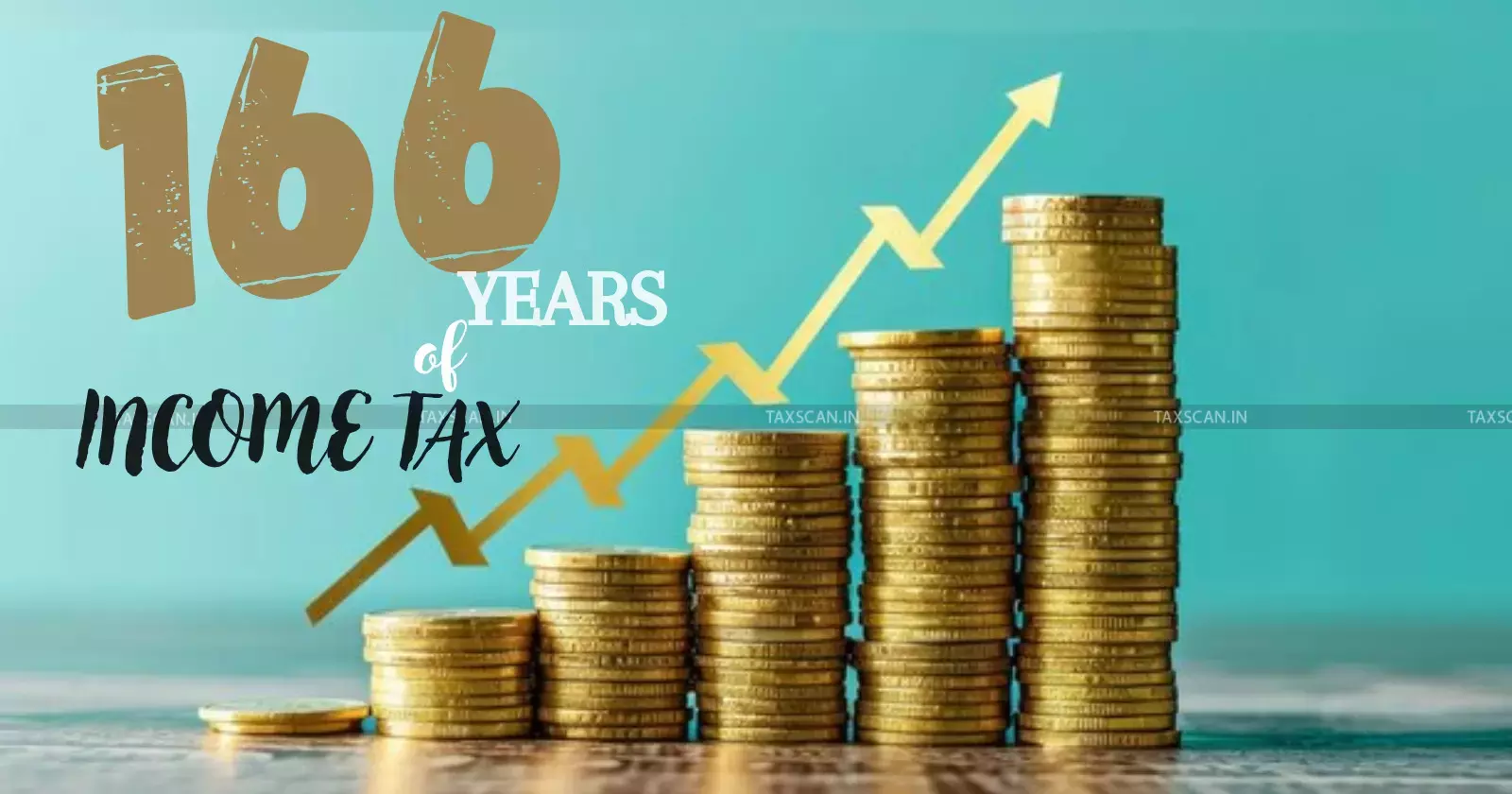166 Years of Income Tax in India: A Look Back at History, Policy, and Progress
India marks 166 years of Income Tax, tracing its journey from colonial roots to a modern, technology-driven system shaped by key legal reforms and landmark court rulings.

India’s income tax system has come a long way since it was first introduced in 1860. What began as a temporary tax to recover from the financial crisis after the 1857 revolt has now become a core pillar of the country’s economic governance. Today, income tax helps fund vital services like education, health, infrastructure, and welfare, with over 8 crore returns filed annually and increasing use of technology for compliance.
Colonial Foundations: The Birth of Income Tax (1860–1921)
Income tax was first introduced in India on February 24, 1860, by Sir James Wilson, the British Finance Minister. The objective was to recover from the Rs. 5 crore financial deficit caused by the Revolt of 1857. This early system taxed four categories: landed property, professions/trades, securities, and salaries/pensions at rates ranging from 2% to 4%.
Although the act expired in 1863, income tax returned in various forms: first as license fees in 1867, and then permanently from 1869 onward. The Indian Income-Tax Act of 1886 formally classified income into schedules and offered exemptions for agricultural income and low-income officials. By 1903, the exemption threshold had risen to Rs. 1,000.
How Does the Supreme Court Shape Tax Laws? Discover Landmark Rulings! Click here
The Early 20th Century
The Income Tax Act of 1918 marked a shift from schedular to total income taxation and made return filing compulsory. This was followed by the 1922 Act, which allowed tax rates to be set annually by the Finance Act and remained effective until 1961. It also centralized tax administration under the Government of India.
The Central Board of Revenue was established in 1924 to strengthen administration, and the Income Tax Appellate Tribunal (ITAT) was set up in 1941 to handle tax disputes.
How Does the Supreme Court Shape Tax Laws? Discover Landmark Rulings! Click here
The Turning Point: Income Tax Act of 1961
After gaining independence, India needed a simplified and modern tax law aligned with its developmental goals. In response, the Income Tax Act, 1961, was enacted and came into effect on April 1, 1962. This comprehensive legislation replaced the 1922 Act and remains the foundation of India’s income tax system today.
The 1961 Act categorized income under five heads:
- Salary
- House Property
- Business/Profession
- Capital Gains
- Other Sources
It also introduced structured assessment procedures, appeals systems, and the Central Board of Direct Taxes (CBDT), which was formed in 1963. The National Academy of Direct Taxes was established in 1957 to train tax officers.
How Does the Supreme Court Shape Tax Laws? Discover Landmark Rulings! Click here
Policy Reforms: High Rates to Rationalization (1960s–1990s)
Initially, India adopted high marginal tax rates. By 1973–74, income tax rates peaked at 97.75% across 11 slabs, reflecting a socialist-leaning approach. However, this stifled economic activity and compliance, with the tax-to-GDP ratio stagnating around 2% until 1990.
The 1991 economic liberalization and recommendations by the Chelliah Committee led to a major overhaul. Tax slabs were reduced to three (20%, 30%, 40%), and the Tax Deducted at Source (TDS) network expanded. These measures nearly doubled the direct-tax-to-GDP ratio to 4% by 2002.
How Courts Shaped the Law
The judiciary has played a central role in clarifying income tax provisions and ensuring fairness in enforcement. One of the earliest and most cited rulings is K.P. Varghese v. Income Tax Officer (1981), where the Supreme Court held that tax authorities cannot arbitrarily add income unless they have proof. This case established that intention and evidence matter, not just assumptions.
In another important case, McDowell & Co. Ltd. v. CTO (1985), the Court distinguished between legitimate tax planning and artificial tax evasion, stating that courts should not allow schemes that defeat the spirit of the law. This decision laid the groundwork for anti-avoidance provisions like GAAR (General Anti-Avoidance Rules), which came into effect in 2017.
The concept of “income” was further clarified in B.C. Srinivasa Setty v. CIT (1981), where the Court ruled that gains from selling self-created goodwill were not taxable capital gains, as they had no cost of acquisition. This judgment continues to influence how capital gains are assessed.
How Does the Supreme Court Shape Tax Laws? Discover Landmark Rulings! Click here
Charitable Trusts and Exemptions
The courts have also played a key role in interpreting tax exemptions for charitable institutions. In Loka Shikshana Trust v. CIT (1975), the Court ruled that not all educational activities are necessarily charitable, especially if profit-making is involved. This case established that charity must not have a profit motive.
In contrast, Ananda Social and Educational Trust v. CIT (2020) brought a modern, progressive view. The Supreme Court ruled that a trust can receive registration under Section 12AA based on its proposed activities even if it hasn't started its charitable work. This was a relief for new trusts trying to establish credibility and claim tax exemption.
Modern Developments and Policy Shifts
India’s tax system has evolved from being complex and compliance-heavy to becoming more digital and taxpayer-friendly. Some key reforms include:
- PAN introduction in 1972 for better taxpayer tracking
- Computerization in 1981 to improve efficiency
- E-filing from 2006 to simplify compliance
In 2020, the New Tax Regime was introduced, offering lower rates with fewer deductions, giving taxpayers the option to choose based on their financial planning style.
Most recently, the New Income Tax Bill 2025 was introduced and cleared by the Union Cabinet. It is scheduled to replace the 1961 Act from April 1, 2026. The new law aims to:
- Simplify language and structure
- Reduce litigation
- Introduce clearer provisions for deductions and assessments
- Harmonize surcharge and cess rules
These reforms continue the spirit of earlier judicial rulings, ensuring taxpayer protection, fairness, and ease of understanding.
Revenue Impact and Compliance Progress
Income tax is now one of the largest sources of revenue for the Indian government. In FY 2023-24, the tax-to-GDP ratio reached 6.64%, the highest in 24 years. More than 8 crore people filed returns. Technology and data integration have made compliance easier, reducing delays and improving transparency.
Still, challenges remain such as tax evasion, a relatively narrow tax base, and complexity in some provisions. Ongoing policy efforts and judicial oversight continue to address these concerns.
Conclusion
Over the past 166 years, income tax in India has evolved from a colonial mechanism to a modern, digital, and essential part of the nation’s economy. Through multiple reforms, legal interpretations, and growing taxpayer participation, the system has matured into one that supports both development and equity.
Support our journalism by subscribing to Taxscan premium. Follow us on Telegram for quick updates


